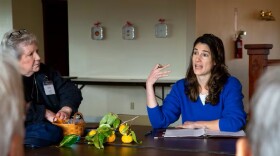One of the most pressing questions in the debate over education funding in Washington state is about how much money should come from local school districts in the form of levies.
Voters around the state see levies on their ballots regularly, but understanding what they have to do with education can get complicated fast.
How Levies Work
There are different types of taxes that can be levied, but when it comes to education, the important one is the property tax. A levy is the action of imposing a tax.
Regular levies come from local governments and excess levies are voted on. Because different taxing districts are raising different levies in addition to statewide taxes, understanding the number on a property tax bill can get complicated fast.
"People think that the city gets all of the money or the state gets all of the money, and it really is divided up," said Pierce County Assessor-Treasurer Mike Lonergan. "Here in Pierce County, there's about 75 different taxing districts that overlap in different ways."
Excess levies are also called 'special levies' because they're intended to pay for things that go above and beyond the basic need. Parks, fire districts and libraries all raise special levies on occasion.
"The area where special levies are far from special is the schools," Lonergan said.
There are four types of levies associated with schools. The ones that voters see most regularly are maintenance and operations levies.
"The controversy has become [that] we shouldn't be depending on voted taxes to provide the basic salaries of teachers and operating costs of heating schools and things like that," Lonergan said.
The Levy Lid And The Levy Cliff
As lawmakers debate how the state is going to pay for education, it's likely the way Washington uses local levy funding will change. But in addition to two general funding plans, the Legislature is also debating a bill specifically about the "levy lid" and the "levy cliff."
Schools' reliance on local levies was the main issue when the state Supreme Court first ruled in 1978 that basic education was the state's responsibility.
The court found that there were two main problems with relying on voted levies. First, they're not a guaranteed source of funding because they can be voted down. Second, they can create inequities when different school districts can raise more or less than others.
To address the problem, lawmakers back then instituted the levy lid — a limit on how much districts can ask for from voters.
The lid is a number, specifically a percentage of all of the money that a school district gets from the state and from the federal government.
By limiting all school districts to a percentage, the hope was that local levy funding would be more evenly distributed. And it would mean the state would be responsible for making up the rest.
When it was first imposed, the lid was 10 percent. It has climbed over the years to the current 28 percent.
The last increase was in 2010, when the Legislature had to make severe cuts to the budget because of the recession. They slashed education funding, but raised the lid so school districts could still get the money they needed.
At the time, legislators imposed a 2018 deadline for the lid to go back down. Two years later, the state Supreme Court ruled that the Legislature was not meeting its constitutional obligation to fund basic education.
By imposing that deadline, lawmakers had created what is now called the levy cliff.
If the lid is a number, the cliff is a date: Jan. 1, 2018. It's the date the lid goes from 28 percent to 24 percent, which means school districts won't be able to ask for as much money from voters.
Shortfall For Schools
The upcoming cliff has school districts worried about huge budget shortfalls. In Seattle, schools may lose as much as $74 million.
But smaller districts will also be affected. The Franklin-Pierce School district spans about 16 square miles in Parkland, just outside of Tacoma.
The district is relatively tax-poor. Home values are mostly in the middle range and the area's largest employer is exempt from taxes.
Despite that, Franklin-Pierce Superintendent Frank Hewins said they've been able to pass a maintenance and operations levy every four years.
He said his district stands to lose more than $5 million if the levy lid goes down.
"If you lose capacity from your levy that the voters already passed, that's a big hit," Hewins said.
Some lawmakers say that extending the cliff will only exacerbate the problems the state has now with local levy funding. They argue that the lid increase was always meant to be temporary and the focus should be on changing the system as a whole.
But Hewins and other school administrators say it's a timing issue; schools have to start building their budgets and may have to make cuts before the legislative session is over.
"Until they can figure that out, we need to make sure that they are doing no harm in the meantime," Hewins said.
This story is part of our series, "Unpacking Government."







